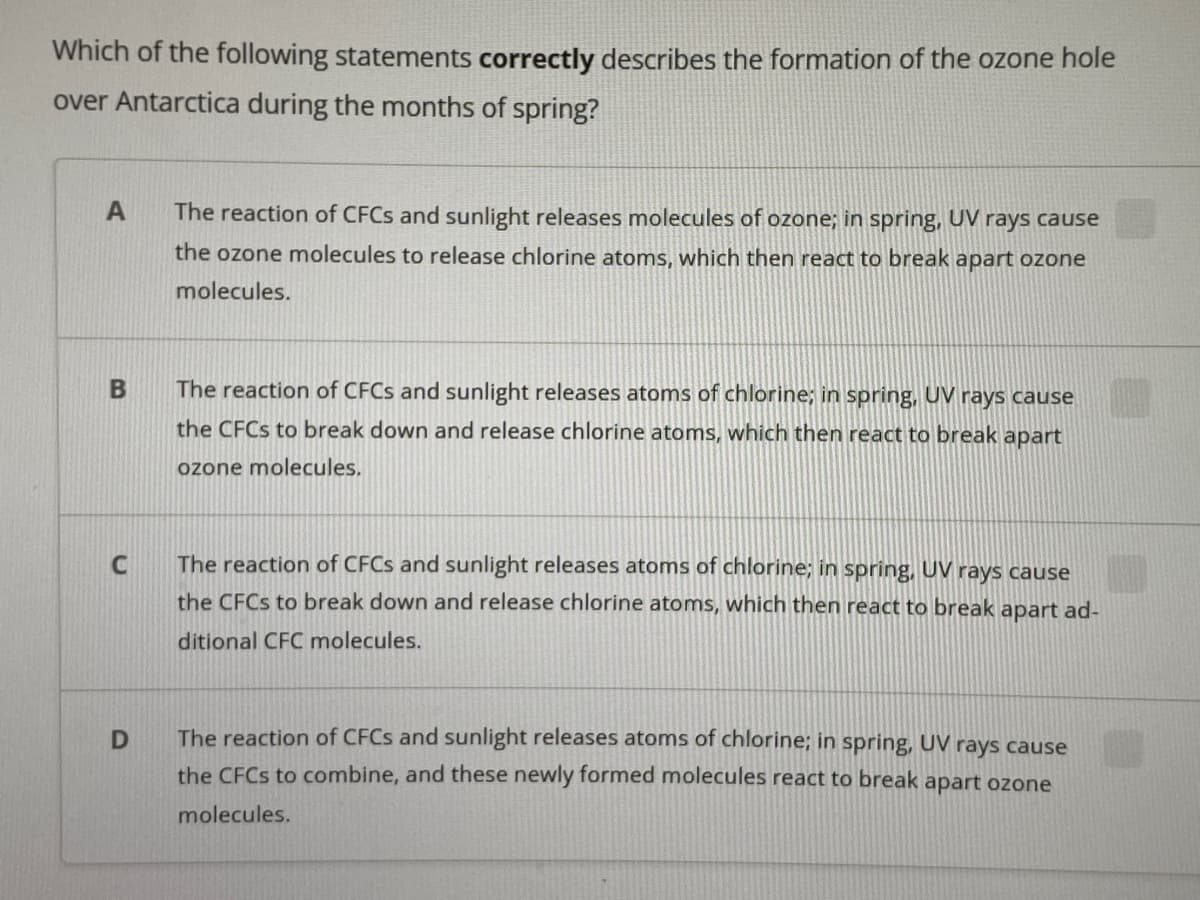Which of the following statements correctly describes the formation of the ozone hole over Antarctica during the months of spring? A The reaction of CFCS and sunlight releases molecules of ozone; in spring, UV rays cause the ozone molecules to release chlorine atoms, which then react to break apart ozone molecules. The reaction of CFCS and sunlight releases atoms of chlorine; in spring, UV rays cause the CFCS to break down and release chlorine atoms, which then react to break apart ozone molecules. The reaction of CFCS and sunlight releases atoms of chlorine; in spring, UV rays cause the CFCS to break down and release chlorine atoms, which then react to break apart ad- ditional CFC molecules. The reaction of CFCS and sunlight releases atoms of chlorine; in spring, UV rays cause the CFCS to combine, and these newly formed molecules react to break apart ozone molecules.
Which of the following statements correctly describes the formation of the ozone hole over Antarctica during the months of spring? A The reaction of CFCS and sunlight releases molecules of ozone; in spring, UV rays cause the ozone molecules to release chlorine atoms, which then react to break apart ozone molecules. The reaction of CFCS and sunlight releases atoms of chlorine; in spring, UV rays cause the CFCS to break down and release chlorine atoms, which then react to break apart ozone molecules. The reaction of CFCS and sunlight releases atoms of chlorine; in spring, UV rays cause the CFCS to break down and release chlorine atoms, which then react to break apart ad- ditional CFC molecules. The reaction of CFCS and sunlight releases atoms of chlorine; in spring, UV rays cause the CFCS to combine, and these newly formed molecules react to break apart ozone molecules.
Chemistry: The Molecular Science
5th Edition
ISBN:9781285199047
Author:John W. Moore, Conrad L. Stanitski
Publisher:John W. Moore, Conrad L. Stanitski
Chapter8: Properties Of Gases
Section: Chapter Questions
Problem 103QRT
Related questions
Question

Transcribed Image Text:Which of the following statements correctly describes the formation of the ozone hole
over Antarctica during the months of spring?
The reaction of CFCS and sunlight releases molecules of ozone; in spring, UV rays cause
the ozone molecules to release chlorine atoms, which then react to break apart ozone
molecules.
The reaction of CFCS and sunlight releases atoms of chlorine; in spring, UV rays cause
the CFCS to break down and release chlorine atoms, which then react to break apart
ozone molecules.
The reaction of CFCS and sunlight releases atoms of chlorine; in spring, UV rays cause
the CFCS to break down and release chlorine atoms, which then react to break apart ad-
ditional CFC molecules.
The reaction of CFCS and sunlight releases atoms of chlorine; in spring, UV rays cause
the CFCS to combine, and these newly formed molecules react to break apart ozone
molecules.
Expert Solution
This question has been solved!
Explore an expertly crafted, step-by-step solution for a thorough understanding of key concepts.
This is a popular solution!
Trending now
This is a popular solution!
Step by step
Solved in 2 steps

Knowledge Booster
Learn more about
Need a deep-dive on the concept behind this application? Look no further. Learn more about this topic, chemistry and related others by exploring similar questions and additional content below.Recommended textbooks for you

Chemistry: The Molecular Science
Chemistry
ISBN:
9781285199047
Author:
John W. Moore, Conrad L. Stanitski
Publisher:
Cengage Learning

Chemistry
Chemistry
ISBN:
9781305957404
Author:
Steven S. Zumdahl, Susan A. Zumdahl, Donald J. DeCoste
Publisher:
Cengage Learning


Chemistry: The Molecular Science
Chemistry
ISBN:
9781285199047
Author:
John W. Moore, Conrad L. Stanitski
Publisher:
Cengage Learning

Chemistry
Chemistry
ISBN:
9781305957404
Author:
Steven S. Zumdahl, Susan A. Zumdahl, Donald J. DeCoste
Publisher:
Cengage Learning


Chemistry: An Atoms First Approach
Chemistry
ISBN:
9781305079243
Author:
Steven S. Zumdahl, Susan A. Zumdahl
Publisher:
Cengage Learning

Chemistry: Principles and Reactions
Chemistry
ISBN:
9781305079373
Author:
William L. Masterton, Cecile N. Hurley
Publisher:
Cengage Learning

General Chemistry - Standalone book (MindTap Cour…
Chemistry
ISBN:
9781305580343
Author:
Steven D. Gammon, Ebbing, Darrell Ebbing, Steven D., Darrell; Gammon, Darrell Ebbing; Steven D. Gammon, Darrell D.; Gammon, Ebbing; Steven D. Gammon; Darrell
Publisher:
Cengage Learning